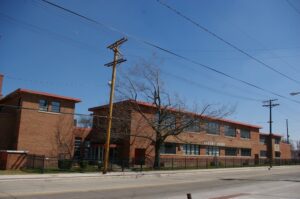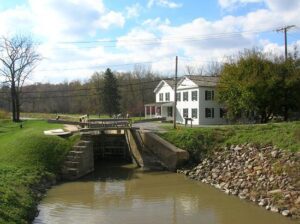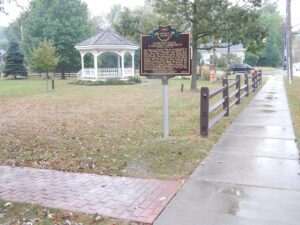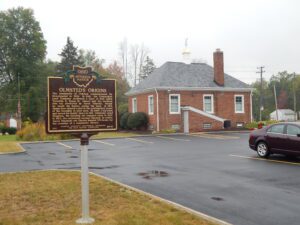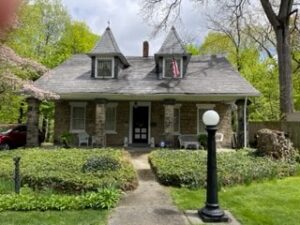, OH
Thousands of Irish immigrants came to Columbus to seek personal and religious freedom. With the “Great Hunger” in Ireland and the completion of the Ohio and Erie Canal and the National Road, immigration to Columbus increased in the mid nineteenth century. They initially settled in the north side of the city in the swamp flats, where inexpensive land was available and work could be had on the railroads. Settlement spread to Franklinton, on Naghten Street, later known as “Irish Broadway”- part of which is now Nationwide Boulevard, and to nearby Flytown. The immigrants became domestic workers, civil servants, entrepreneurs, and served the city in police and fire departments. Others were leaders in government, law, medicine, and education. Their legacy continues today in the Irish-American population of Columbus, Ohio.
, OH
Construction for the current St. Anthony Church began in 1890 after the original wood-frame church became too small to serve the steadily growing congregation of Polish immigrants coming into the Toledo area. Completed in 1894, St. Anthony was the second Polish church built in Toledo and became known as the “mother” church for the local Polish community serving as many as 8,000 parishioners piror to the 1970s. The first Mass was celebrated on March 4, 1894. (continued on other side)
, OH
Karamu House, Incorporated was established in 1915 as the Playhouse Settlement, one of Cleveland’s many settlement houses for migrant and immigrant communities. Initiated by the Men’s Club of the Second Presbyterian Church, in 1915 Oberlin College and University of Chicago social work graduates, Russell and Rowena Woodham Jellliffe were hired as the founding directors. Originally located at 2239 East 38th Street, the Playhouse Settlement offered children’s theater and other social, recreational, and educational activities. It soon developed a partnership with the Dumas Dramatic Club, a local African American theater company that later became known as the Gilpin Players. (continued on other side)
, OH
Directly across the Cuyahoga River from this spot is the South Park Village. Here, archeologists uncovered the remains of a four-acre, Native American settlement populated by people of the Whittlesey Tradition. The people of South Park lived in communal structures and grew maize, beans, and squash in the floodplain fields that surround you. Food remains found in the village excavations reveal that they hunted deer, elk, black bear, and other game and gathered clams and fish from the Cuyahoga River. South Park was abandoned and reoccupied several times between A.D. 1000 and 1600. Numerous seasonal campsites have been found on the floodplains and terraces on both sides of the river. The first localized cultural development unique to this area, Whittlesey sites have been identified upriver from here in Summit County and in the Chagrin and Grand River valleys to the east.
, OH
In 1795, the Connecticut Land Company auctioned twenty-five square miles of land known as Plum Creek Township. Aaron Olmsted, a sea captain, purchased almost half of the property. Although Olmsted died before ever seeing his land, in 1829, his son Charles offered to donate books to the area in exchange for changing the settlement’s name from Lenox to Olmsted. In 1815, shoemaker James Geer and his family became the first permanent American residents to settle in the southern end of the area. Geer’s farm was on what is now Columbia Road.
, OH
The community of Olmsted commemorated its bicentennial in 2014. In 1795, the Connecticut Land Company auctioned a tract of land called Township 6, Range 15. Almost half the northern side was purchased by Aaron Olmsted, though he would die before seeing the land. In 1814, James Geer cleared a plot in the southeastern corner of the township to grow corn. He built a log house and moved his family there. Originally called Kingston, the township was renamed Lenox in 1823. In 1829, the settlement became Olmsted; in return, Aaron Olmsted’s son Charles donated 500 books for the creation of a community library.
, OH
The Curtis-Preyer Stone House takes its name from two families associated with its early history. Richard and Clarissa Dille Curtis purchased 70 acres in the Connecticut Western Reserve from veteran Elias Lee in 1819. The Euclid Township “Turkey Knob” settlement soon thrived around Dugway Brook, springs sites, and an American Indian crossroads. The Curtis, Dille, Lee, and Stillman families, related by marriage, helped each other succeed by harnessing the creek to power their grist and saw mills and selling quarried stone and felled timber. Sometime between 1819 and 1835 Curtis built his stone house using the Berea sandstone quarried on site. The roof was created of ax-hewn “pegged” tree timbers, and the thick stone walls fashioned of uncoursed, chiseled stones. A central chimney fed seven fireplaces and a bake oven.




